No one could believe where my 20-year tradition of decorating our school garden came from.
After all, who would ever dream a family tradition that my mother started over 50 years ago could still impact children these days? Mom had no idea she was engaging in inquiry based learning with her 5, 8, 10 and 11-year-olds. Beginning in the 1960’s and 70’s, she partnered with us to decorate our bedrooms as different countries celebrating Christmas and winter holidays.
And one final highlight? Creating a feast for the birds and animals just outside our back door that lasted long after all the holiday decorations were packed away!
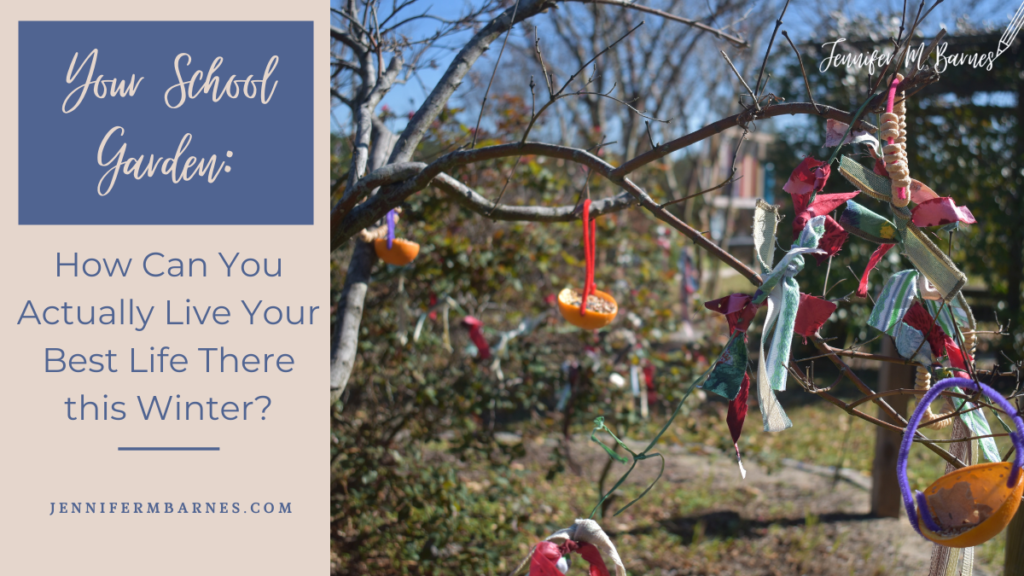
Years later in my kindergarten, I adapted Mom’s idea into our Garden Decorating Day. Our celebration hinged upon Night Tree, written by children’s author Eve Bunting. Children through the years adored the story of a family who treks out into the woods one cold winter evening – not to cut a tree down and bring home, but to decorate it there in the forest as a gift to the animals. Sighs echoed throughout the classroom as we gazed at the last page spreads. There, the child is snuggled under his snowy forest quilt, imagining the varied critters crowding around his tree, partaking of their gift
Some little voice always predictably piped up, wondering why we couldn’t do the same thing. I relished hearing the subsequent talk flow. And before you knew it, eyes brightened and heads perked up to realize we actually could do our own version of Night Tree right outside our classroom in our Storybook Garden.
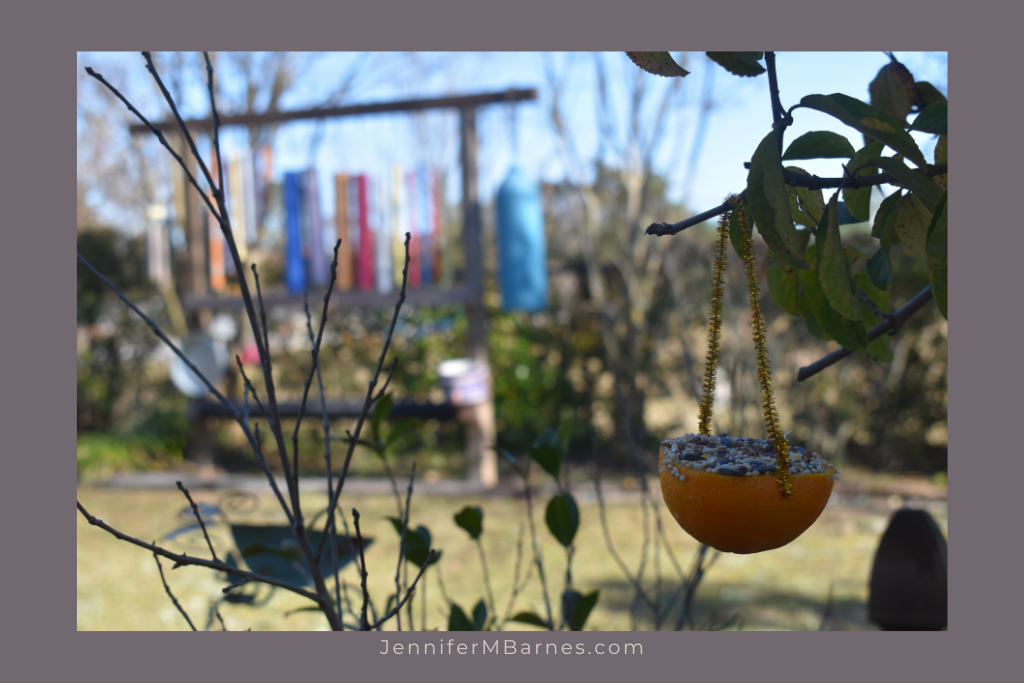
Math Workshop in Our Outdoor Environments
So the work began. I invited children to envision what they felt our school garden creatures would love and could use during winter. Next we drafted a list of things we needed and worked to calculate the number of supplies. We also “browsed” the Internet (of a few sites I’d previously chosen) and the dreaming began to turn into action.
Our Math Workshop transformed into authentic work with these numbers.
I invited the children to figure problems like the following:
- How many pipe cleaners do we request if every child in the class needs two?
- One orange created baskets for two children. If we have 22 students in our class, how many oranges do we need in all?
- How many bags of birdseed should we get for our school garden?
- Show a ruler. Talk about the inch marks and numbers along its side. Have children figure out how long to make the paper strips (for paper chains). If they say 4 inches, cut a four-inch strip and try to tape it into a circular piece for a chain. Immediately, they’ll realize the strips need to be longer. (Although I end up cutting strips with a paper cutter, analyzing the desired size is a thoughtful engagement for the children.)
We published the detailed list on our class blog for families to donate and plotted our Winter Garden Decorating Day onto our calendar. Classes through the years often invited parent and grandparent volunteers or our fifth grade buddies to join us.
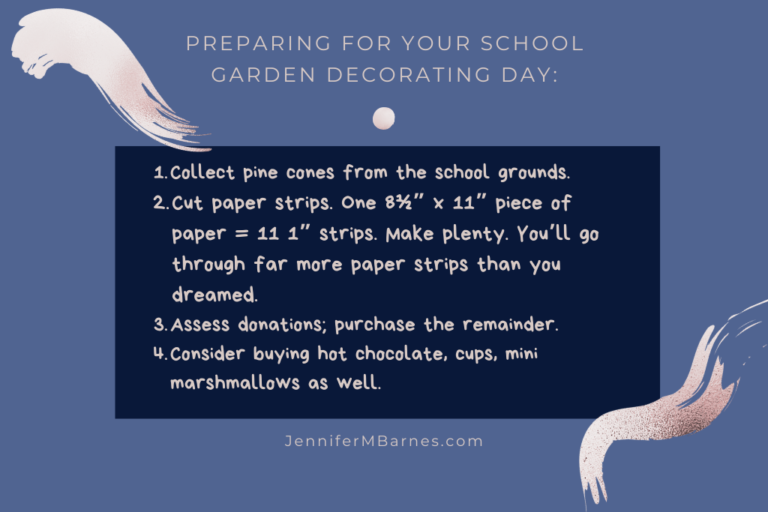
Planning Considerations for these Winter Activities in Kindergarten
Easier activities kids can do themselves:
- Paper Chains
Paper strips, several tape dispensers, tape refills
- Cheerio Wreaths
Pipe cleaners – at least 2 per child, 1 box of Cheerios (or similar ring-shaped cereal), several bowls for the cereal pieces
Activities that need more teacher assistance:
- Puff Popcorn Garlands
Puff popcorn, plastic embroidery needles taped to the table, fishing line
- Cranberry Garlands
Cranberries, plastic embroidery needles taped to tables, fishing line
Messy Alert!
- Orange Bird Seed Baskets
Oranges (cut in half), spoons, bowls for children to collect their gooey orange pulp, birdseed, ½ pipe cleaner (adults gently poke through the orange edges to create a basket shape)
- Peanut Butter Pine Cones
Large pinecones, plastic knives, peanut butter, birdseed
- Cookie Cutter Birdseed Ornaments
Cookie cutters, birdseed, straws (to make holes), ribbons to hang
(Note: Different volunteers over the years have experimented with varying recipes. I’ve seen recipes ranging from gelatin and boiling water to coconut oil. Definitely find one prior to this experience that works well in your climate.)
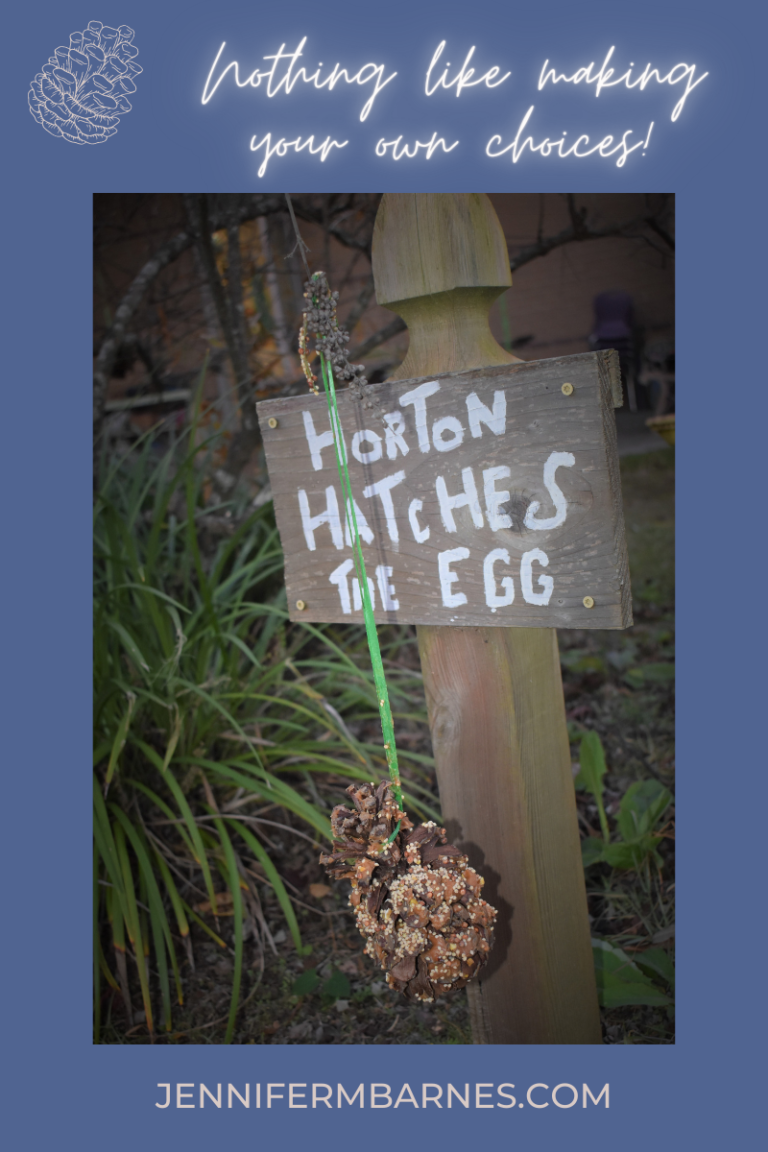
Different Emphases Over the Years that have Made Each Experience Unique
Since each class engages in inquiry based learning based on their interests and talents, unique emphases for this project have surfaced over the years from fabric studies and recycled decor to an inquiry into lights and colors. Many of these kindergarten garden activities promote the use of fine motor skills, problem-solving, and positive small-group conversations.
Fabric and Quilt Studies have enhanced our school garden with textures, patterns, and softness. We used:
- Simple fabric pieces our children cut in long strips and then tied throughout the garden. This cutting is great for their fine motor skills! Children trailed ribbons and fabric from tree limbs and fencing to signposts and animal statuary.
- More of these fabric strips to tie to long strips of jute, creating garlands of streamers. These festive garlands fancied up some of the bare trees throughout the winter.
Recycled Decor found its way into one group’s engagements. The goal was to purchase nothing, but to use whatever we already had. These children chose to:
- String spray-painted aluminum cans (with holes drilled through the ends) using a more rigid fishing line. (I was grateful for some inventive parent volunteers who tackled this whole project.)
- Create stick art to grace our winter decor and our individual homes. Children collected interesting sticks from the school grounds to recycle into art. These beautiful family garden gifts inspired the children’s families to create feasts for their critters and creatures at their own homes.
An Inquiry into Lights and Colors inspired yet another group to string white and colored light strands throughout the garden, illuminating the space and casting shadows.
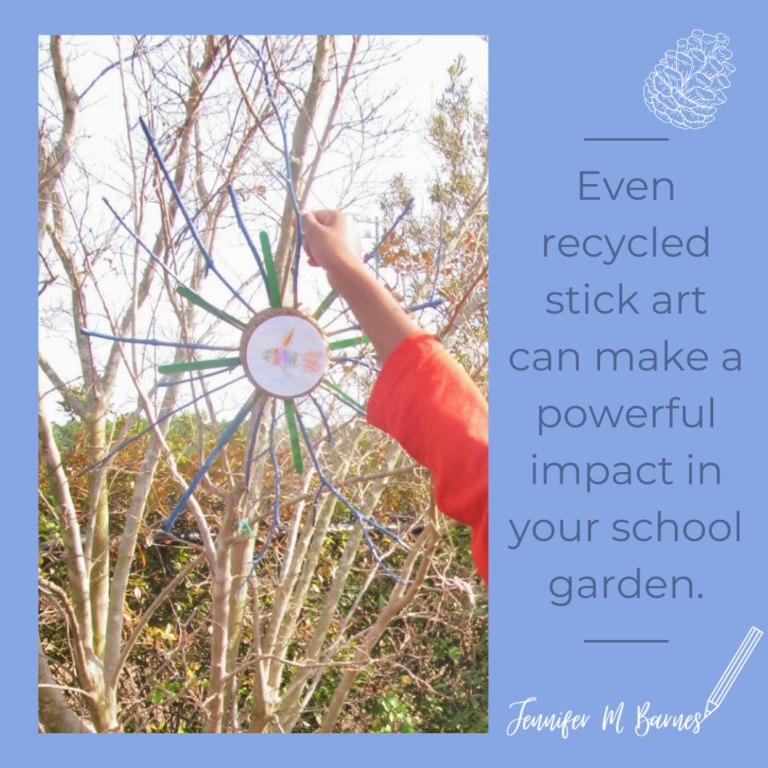
Safety Considerations
Be aware of your children’s allergies. Be sure to inform volunteers, guests, and families of the use of peanut butter for all children throughout the decorating process. Consider drafting signage for the garden area that warns school garden visitors of the use of peanut butter as well.
Timing Considerations
- Check the weather forecast. One year we created beautiful decorations and placed them all over the school garden – just before a huge storm blew through!
- Although some teachers “save” outdoor experiences for the holiday week, consider doing them much earlier or later. When children are at school, they can enjoy watching the animals.
- Remember to provide food for animals throughout the winter. Replenish the food through January, February, and March.
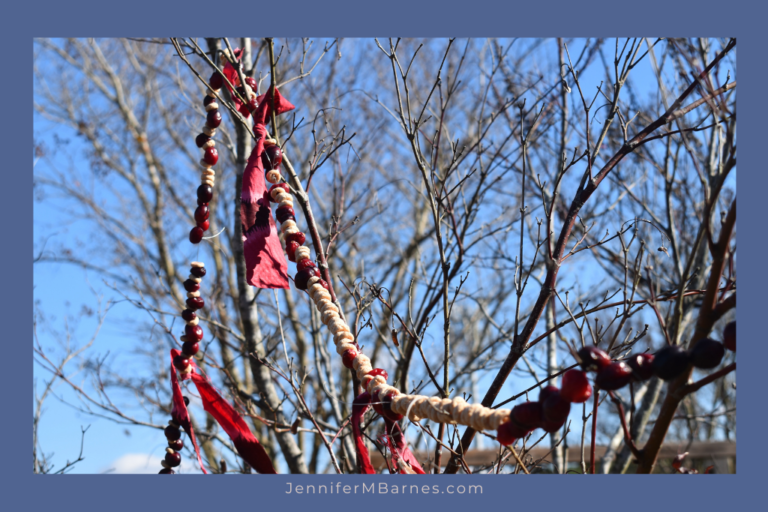
Surviving the Entire Experience:
A Step-by-Step Guide
The Day Before
- Reread the book, Night Tree.
- Lead a class conversation on any remaining thoughts or ideas.
- Remind children of thoughtful “rules” to consider in each station of work.
Garden Decorating Day, Part 1:
Creating the Decorations (Morning)
- Have stations set up across the room. Only put enough chairs for the number of children permitted in that area at one time.
- Set up a book-browsing station for children who are waiting on their turn at a particular station.
- Prepare independent stations: Cheerio Wreaths and paper chains.
Messy Alert!
- Prepare the messy stations: peanut butter on pinecones, orange baskets, and cookie-cutter birdseed ornaments. Definitely put adult volunteers here.
- Note: Scooping orange halves is hard! Although some children don’t like scooping out the orange pulp, they all adore getting to fill the little orange baskets with birdseed and select perfect spots in the garden to hang them. So, encourage children to persevere at this messy station.
Patience required…
- Many children learn patience at this station as they work to thread the needle through the fattest part of the puff popcorn and carefully pull it all the way through before sticking the next piece on. Most children struggle to make a whole string of popcorn; so, they take turns here. As the strands fill, the adult volunteer can simply tie them all together to place on one smaller, bare tree. Stringing the cranberries is much easier, but still takes patience.
Pro tip:
Cut a yard of fishing line, slide a medium-sized plastic embroidery needle to the middle and tape both ends of the fishing line to the table. That way, the pieces can’t fall off the back as children string them and they can’t pull their needle off their string. The larger, the puff popcorn – the better! But, the larger the needle, the more likely the puff popcorn will break. It’s a delicate balance for sure!
Suggested length of creating time for 22 children: 2 hours.
We always began right at school opening time as a convenience for any parent volunteers wishing to assist before heading out for their normal day. An earlier start time would also give us enough time to complete the work before lunch.
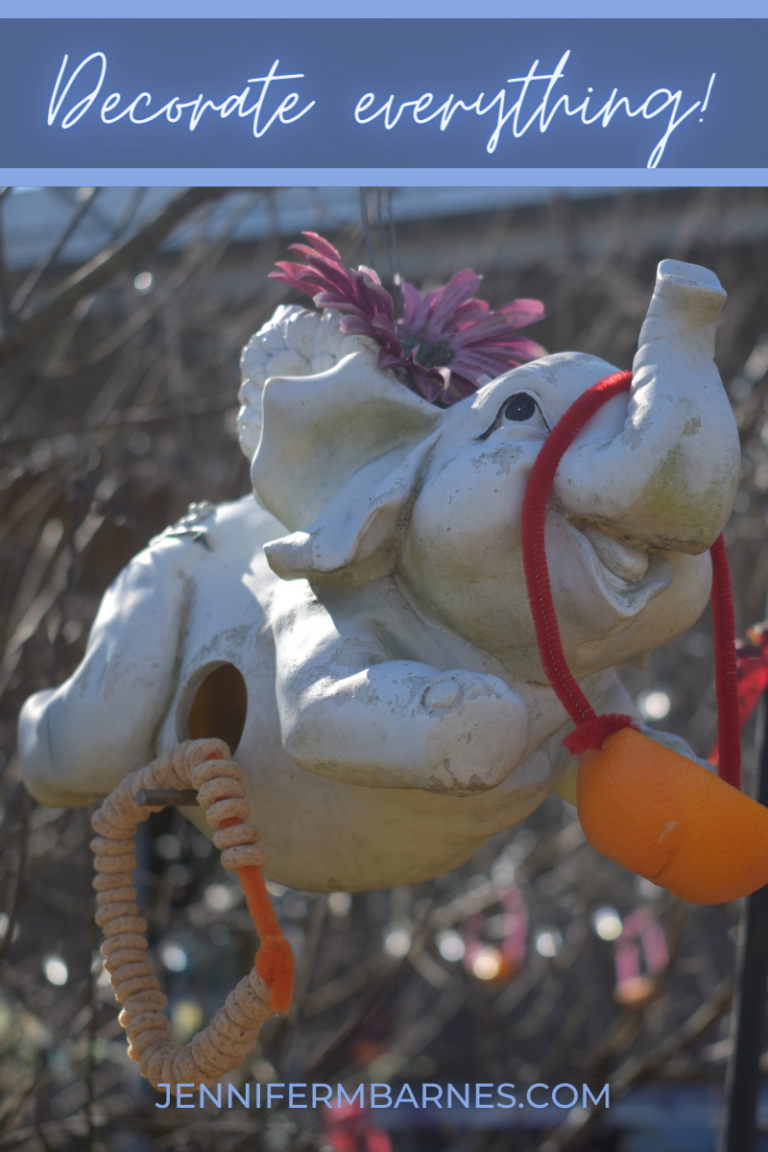
Garden Decorating Day, Part 2:
Festooning the Garden (Afternoon)
Supplies: Ladder for adults, step stools.
Bring out your camera and capture the joy of children spreading their feast throughout your school garden space. These kindergarten garden activities become favorite memories. Since children had already dispersed their birdseed pinecones, they probably had begun noticing where others hung their ornaments and making plans of their own.
Typically, I invited the children who persevered longest on the popcorn chains to drape that garland on the bare tree. Others can take their cranberry strands to hang in their choice of places.
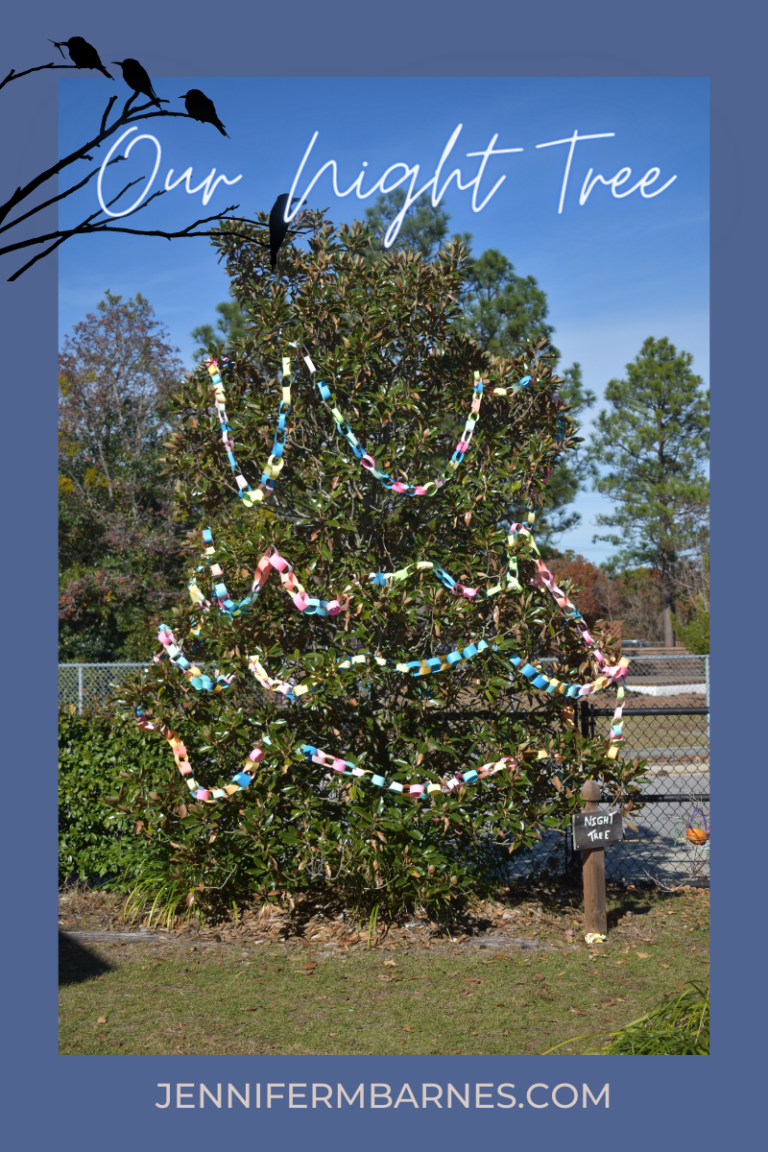
Our Night Tree
Since we had an official “Night Tree” (designated Magnolia tree) in our garden, we always taped the paper chains together to create one huge chain. The children loved lining up and helping to carry the long chain to the tree where I had tall volunteers, step stools, and a ladder for adults to complete draping the chain. Send a child volunteer back to the room for an extra tape dispenser for the little tears that happen in the moment.
It’s amazing how quickly twenty-two children can decorate a garden! Once the decorations were distributed, I invited children to walk along with me and “ooh and ahh” over the beautiful displays they created.
… and our celebration!
We always ended the joyous day at our “Night Tree” where I invited them to sit around it. There, we took suggestions of their favorite songs (just like the children in our mentor text). And just as Nina, the little sister in the story, suggested “Old McDonald Had a Farm,” we always giggled as we sang through multiple animal verses of it, too.
By that time, our hard-working volunteers brought hot chocolate for us to sip and simply enjoy the spirit of the day. Such kindergarten garden activities are the ones families look back on and fondly remember.
Suggested time: 45 – 60 minutes.
I always preferred that children got packed and ready for home early so they would be totally prepared for dismissal. That last hour was reserved for decorating and celebrating. Since it was close to dismissal, parent volunteers could easily join us in the garden to decorate, take photographs, and/or help prepare cups of hot chocolate.
As carpool began in the afternoon and the cars drove past our garden, we always heard families exclaim over the beauty of the space and their child’s excitement from the day. And we knew that each following day would just get better as we observed visiting wildlife from our windows.
This day was just the beginning of many marvelous winter learning engagements!

Curricular Follow-Ups for our Winter Activities in Kindergarten
- A Citizen Science Experience: Be sure to place sketch pads, colored pencils, and binoculars close to the windows for children to capture those special visitors from the kindergarten garden activities.
- Print photographs from Garden Decorating Day and adhere to a cardstock background. During Writing Workshop, invite children to select a photo to craft a caption and/or narrate the experience.
- Prior to hanging the paper chain, “measure” its length by stretching it across the room. (Try to compare similar lengths: “Ten chairs long, the length of two carpets, or from the door to the window.”) Later estimate the number of feet long their measurements were. Follow up with measuring tapes to check their estimate from this inquiry based learning experience.
- Using a sketchpad, sketch:
- Directions for a particular recipe. (For example, How to Make a Cheerio Wreath.)
- An illustration of the completed school garden.
- A design of a completed ornament with labels.
- Showcase a “book-tasting” so children can see a variety of books from different holidays, traditions, and experiences.
- During another Writing Workshop, invite children to share the story of their family traditions through a comic strip template or traditional writing paper.
- Research winter traditions across the globe.
- Be sure to incorporate the concepts of caring for animals during the winter months and how those animals change over time. A number of science standards can be easily met through such learning.
There you have it!
Some of my most relevant inquiry based learning (and wonderful memories) have come through this winter tradition. My biggest suggestion would be to start small. Pick one or two things you’d like to try – even if it’s just on a regular winter day and see how it goes. It’s easy to add on more and more just as I’ve done through the years. We didn’t always do every single thing every single year; but, the creating, caring for animals, and celebrating always happened. Feel free to drop a comment below with other suggestions for us to try. And be sure to savor the season!
Are you wondering more about what inquiry based learning is all about? Check out this post where I share how our basic study of water ended up transforming a whole village (and all of our lives, too!) What Inquiry Based Learning Is: How Could Thoughtful Kindergartners Impact a Village? – Jennifer M. Barnes (jennifermbarnes.com)

Pingback: Valentine’s Day Kindergarten Ideas: How to Promote Great Friendships and Meaningful Writing - Jennifer M. Barnes
Pingback: Four Thrilling Ways to Create Your Amazing Kindergarten Classroom Setup - Jennifer M. Barnes
Pingback: Being There: How to Move From Engaging Literacy to Powerful Life-Changing Experiences - Jennifer M. Barnes